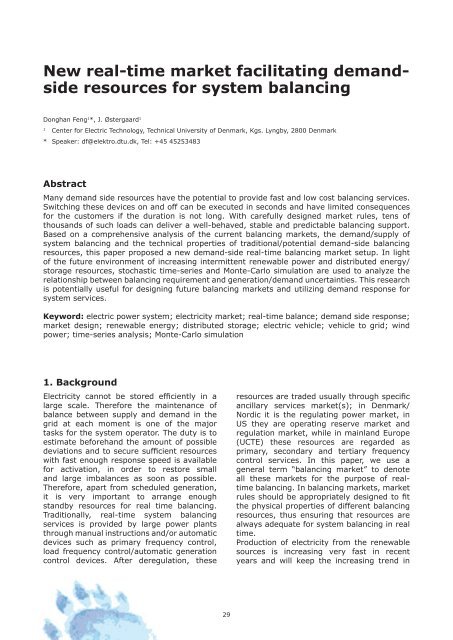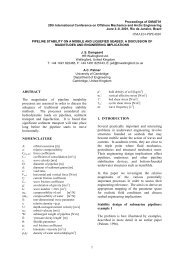Energiforsyning i Arktis – hvilken vej vælger Grønland? - Artek ...
Energiforsyning i Arktis – hvilken vej vælger Grønland? - Artek ...
Energiforsyning i Arktis – hvilken vej vælger Grønland? - Artek ...
You also want an ePaper? Increase the reach of your titles
YUMPU automatically turns print PDFs into web optimized ePapers that Google loves.
New real-time market facilitating demandside<br />
resources for system balancing<br />
Donghan Feng 1 *, J Østergaard 1<br />
1 Center for Electric Technology, Technical University of Denmark, Kgs Lyngby, 2800 Denmark<br />
* Speaker: df@elektro dtu dk, Tel: +45 45253483<br />
Abstract<br />
Many demand side resources have the potential to provide fast and low cost balancing services<br />
Switching these devices on and off can be executed in seconds and have limited consequences<br />
for the customers if the duration is not long With carefully designed market rules, tens of<br />
thousands of such loads can deliver a well-behaved, stable and predictable balancing support<br />
Based on a comprehensive analysis of the current balancing markets, the demand/supply of<br />
system balancing and the technical properties of traditional/potential demand-side balancing<br />
resources, this paper proposed a new demand-side real-time balancing market setup In light<br />
of the future environment of increasing intermittent renewable power and distributed energy/<br />
storage resources, stochastic time-series and Monte-Carlo simulation are used to analyze the<br />
relationship between balancing requirement and generation/demand uncertainties This research<br />
is potentially useful for designing future balancing markets and utilizing demand response for<br />
system services<br />
Keyword: electric power system; electricity market; real-time balance; demand side response;<br />
market design; renewable energy; distributed storage; electric vehicle; vehicle to grid; wind<br />
power; time-series analysis; Monte-Carlo simulation<br />
1. Background<br />
Electricity cannot be stored efficiently in a<br />
large scale Therefore the maintenance of<br />
balance between supply and demand in the<br />
grid at each moment is one of the major<br />
tasks for the system operator The duty is to<br />
estimate beforehand the amount of possible<br />
deviations and to secure sufficient resources<br />
with fast enough response speed is available<br />
for activation, in order to restore small<br />
and large imbalances as soon as possible<br />
Therefore, apart from scheduled generation,<br />
it is very important to arrange enough<br />
standby resources for real time balancing<br />
Traditionally, real-time system balancing<br />
services is provided by large power plants<br />
through manual instructions and/or automatic<br />
devices such as primary frequency control,<br />
load frequency control/automatic generation<br />
control devices After deregulation, these<br />
29<br />
resources are traded usually through specific<br />
ancillary services market(s); in Denmark/<br />
Nordic it is the regulating power market, in<br />
US they are operating reserve market and<br />
regulation market, while in mainland Europe<br />
(UCTE) these resources are regarded as<br />
primary, secondary and tertiary frequency<br />
control services In this paper, we use a<br />
general term “balancing market” to denote<br />
all these markets for the purpose of realtime<br />
balancing In balancing markets, market<br />
rules should be appropriately designed to fit<br />
the physical properties of different balancing<br />
resources, thus ensuring that resources are<br />
always adequate for system balancing in real<br />
time<br />
Production of electricity from the renewable<br />
sources is increasing very fast in recent<br />
years and will keep the increasing trend in





